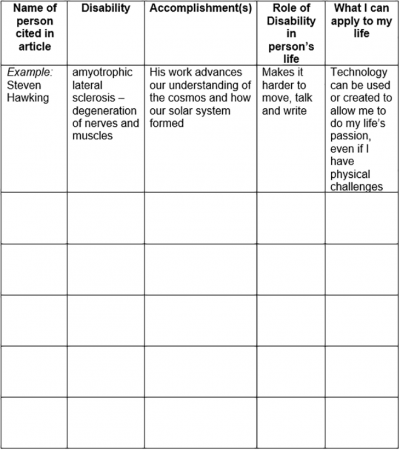Educator Guide for ‘Disabilities don’t stop these experts in science and tech”

Scientists, engineers and mathematicians with disabilities tend to toil away largely outside the public eye. But their disabilities don’t define them.
Wavebreakmedia/iStockphoto
To accompany feature “Disabilities don’t stop these experts in science and tech”
Introduction
We all have challenging days. but for some people, getting through a day can be more difficult due to visible or invisible disabilities. This article invites students to think about what can be accomplished despite or because of personal challenges. The article can help to explore perceptions about disabilities as well as support topics you may already be teaching in biology, physics or ecology.
Connections to Curricula
- tolerance
- physics of explosions
- health and safety
- forest ecology
- urban ecology
- animal behavior
- career pathways
Standards alignment
Science: MS-PS3-2, MS-PS4-1, MS-LS1-5, MS-LS2-1, MS-LS2-4, MS-LS2-5, MS-ESS1-2, MS-ESS3-3, MS-ETS1-2, HS-PS2-1, HS-PS4-1, HS-LS2-6, HS-LS2-7, HS-LS2-8, HS-ESS1-4, HS-ESS2-2, HS-ESS3-4, HS-ETS1-2
Language Arts:
- Informational text (RI): 1, 2, 4, 6, 7
- Writing (W): 1, 2, 3, 6, 8, 9
- Speaking and Listening (SL): 1
- Reading Standards for Literacy in Science and Technical Subjects (RST): 1, 2, 5, 7, 9
- Standards for Literacy in History/Social Studies, Science, and Technical Subjects (WHST): 1, 2, 4, 6, 8, 9
Mathematics: 7.G.4
How to use this Science News for Students article
Note: Students might know people who have physical or learning disabilities. There may be some in your class. This can be an opportunity to build a new level of awareness, respect and sensitivity around disabilities. As with any lesson that focuses on people’s abilities, be sensitive and set ground rules for appropriate behavior.
- You might want to open the lesson by asking students if they know anyone who has a disability. This can lead to some stories about the disability and the challenges that this person faces day-to-day. With each story, ask if there is something that this person can do better than the student to highlight that having a disability can also mean the disabled person has areas of strength. Students may know people with disabilities that have accomplished amazing feats [One example: Jeff Glasbrenner was the first paraplegic to climb Mt. Everest.].
- Extension: Have students take a disability awareness quiz. Your local school district might have one, or you can create your own using this guide to disability awareness. Students could take the quiz to see what they think at the beginning of this lesson and retake it again later to see if their awareness has changed. They can even give it to a wider group around the school to determine whether the level of awareness within your class is different from the larger community.
- Extension: Students may want to create an awareness campaign about disabilities as a result of their experience, based on this article.
- Extension: Have students take a disability awareness quiz. Your local school district might have one, or you can create your own using this guide to disability awareness. Students could take the quiz to see what they think at the beginning of this lesson and retake it again later to see if their awareness has changed. They can even give it to a wider group around the school to determine whether the level of awareness within your class is different from the larger community.
- Ask students what they think the term disability means. Ask questions such as: “Can you always see a person’s disability? Why or why not?” [Students may recognize that some disabilities, such as learning disabilities, are harder to see or notice than physical ones, such as being blind or deaf.] Students might want to do a bit of research to list different types of disabilities and sort them as visible or not, depending on their background knowledge.
- Have students read the article and highlight important points. Discuss why we read about people who overcome challenges. [We can learn ideas and strategies that can help us overcome our own challenges.] Use the Blackline Master as a guide.
- The article talks about the work of Neil Altomare. Ask students if they know what an IED is and how they work. Students can research how an IED explosion throws heat, gas and material outward from the center in all directions. You might discuss the vacuum created that causes inward rushing air to pull debris toward the center of the blast. These create what is referred to as a blast radius.
-
Community connection: You might consider inviting your district safety officer or a representative from your local police department to answer students’ questions about ways the community prepares for potential threats.
-
Community connection: You might consider inviting your district safety officer or a representative from your local police department to answer students’ questions about ways the community prepares for potential threats.
- The article introduces the work of Wanda Diaz Merced. Your students might enjoy hearing her TED talk about her work or music inspired by the sonic recordings of space by Hydra Signal. Have students look at an example of a sonified x-ray created by Merced. Discuss definitions of pitch, frequency and volume and how understanding waves can be used in science and music.
- Continue the conversation about the importance of sound as it applies to the work of Richard Mankin. Ask students how they would go about listening to something happening inside a tree. Would they use a microphone? Where would they place it? Students might look at his original research to describe how he used sound pulses to determine whether a tree is infected by termites. Select a graph from his research to project and discuss.
- Extension: Share the TED talk from Bernie Krause on the sound of the forest. Engage students in a discussion on the difference between what the forest looks like over time and how it sounds. Students can compare his thinking to Diaz Merced’s statement, “you see better when you use sound” and the work of Mankin. Discuss where the work of these scientists intersects and how they use technology in different contexts to answer their own questions.
- Extension: Share the TED talk from Bernie Krause on the sound of the forest. Engage students in a discussion on the difference between what the forest looks like over time and how it sounds. Students can compare his thinking to Diaz Merced’s statement, “you see better when you use sound” and the work of Mankin. Discuss where the work of these scientists intersects and how they use technology in different contexts to answer their own questions.
- Ask students what they think about Naomi Ondrasek’s work on animal behavior. In biology, we often talk about the process of meiosis to form a gamete and the process of reproduction, but Ondrasek’s work poses questions about how animal behavior changes based on parenting status. Ask students when they think an animal becomes a parent. What behaviors do they think change in the animal? Do all these behaviors happen to both parents? Could stress or pollution affect how an animal parents its young? Students might want to explore some of these questions, starting with information provided on Ondrasek’s website.
- To learn more about Caroline Solomon, students might want to read or listen to National Public Radio’s story on her work. If teaching about ecology, this can spark an exploration into eutrophication, the excessive levels of phosphorus or nitrogen found in bodies of water, often due to runoff. You could begin by having students look at a map of water bodies near where you live for potential sources of agriculture or other fertilizer runoff.
- Extension: Students can look to sources such as USGS.gov for information and examples of eutrophication or use one of many online lesson plans to understand it, such as those by COSEE-MidAtlantic or the American Museum of Natural History.
- Extension: Students can look to sources such as USGS.gov for information and examples of eutrophication or use one of many online lesson plans to understand it, such as those by COSEE-MidAtlantic or the American Museum of Natural History.
- After learning about the work of some of the scientists, mathematicians and engineers highlighted in this article, ask students whether they think each person’s disability kept them from making an impact on what we know about the topics they study. How might this influence students’ thinking about people with disabilities and what they can accomplish? If people with disabilities can accomplish so much, what message does this send to all of us about overcoming challenges? This is an opportunity to revisit the discussion at the beginning of this guide to find out whether students have changed their opinions or beliefs about what someone with disabilities might look like or accomplish. This could turn into an awareness campaign for students to highlight those within your school or community who have overcome challenges to accomplish noteworthy contributions to science, mathematics, engineering, technology or other fields.
Blackline Master: Key ideas from the article
Directions: When reading, it is often helpful to use a chart or table to keep track of important ideas. Use this graphic organizer to keep track of people and ideas associated with these people.
